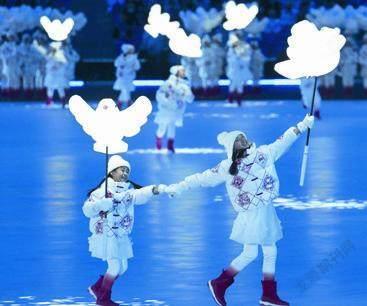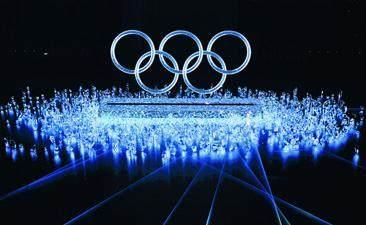LESS IS MORE
By Li Xiaoyang

Unexpectedly simple. The two torchbearers placed the Olympic torch in the middle of a giant snowflake-shaped cauldron and then saw it ascend to the top of the National Stadium, popularly known as the Bird’s Nest, during the Beijing 2022 Winter Olympics opening ceremony on February 4.
“The Olympic spirit is not necessarily shown through a big flame. The fire of one torch can also be a symbol,” Zhang Yimou, chief director of the event, said while elaborating on the ideas behind the innovative cauldron-lighting ceremony.
The giant snowflake was made from 91 smaller snowflake-shaped placards, each with the name of a participating country or region. According to Zhang, one of China’s most famed cinema directors, the joining of the smaller snowflakes to create the larger one symbolizes the building of a community with a shared future for humanity; only through unity can man overcome the pandemic.
Zhang also directed the exceptional opening ceremony of the 2008 Summer Olympics in Beijing. But this time, he aspired to more than just a perfect show. Preparations for this year’s ceremony began in 2019 and, from the very first day, Zhang thought outside the box to deliver Chinese style in a modern and straightforward way.
The 2008 ceremony featured large-scale performances showcasing traditional Chinese culture through the use of flying apsaras, Chinese paper scrolls and traditional instruments. “In contrast to the 2008 opening ceremony, which prominently featured performance in unison, this ceremony centered around natural performances from ordinary people,” Zhang told Xinhua News Agency.
Approximately 15,000 people took part in the performances in 2008. This year, that number was 3,000. None of the performers in the Winter Olympics opening ceremony wore ancient costumes as were seen 14 years ago. In a program that saluted the people of the world, 76 participants from different countries walked shoulder to shoulder through the performance zone against a backdrop of images featuring past Olympic competitions and the global fight against COVID-19.“This part aimed to show ordinary and diverse individuals as an embodiment of the slogan together for a shared future,” Zhang said.
To make the Winter Olympics opening ceremony greener, the use of fireworks was only 10 percent that of the 2008 spectacle.
Moreover, the cauldron-lighting approach echoes China’s low-carbon and environmental protection efforts, according to Zhang. Instead of a flame of the size normally used during Olympic Games, this year a single torch was placed inside the cauldron. The total carbon emissions of the smaller flame during the 17-day Games are estimated to be only one 5,000th of the amount emitted at the 2008 Summer Games.
Rather than depending on largescale performances, the Beijing 2022 opening ceremony focused more on details. The Chinese calendar is divided into 24 seasonal divisions, known as solar terms. As the ceremony coincidently took place on the first day of the first solar term, known as Lichun or the Beginning of Spring, it included a performance in which participants conveyed the vitality of spring by performing while holding illuminated poles that simulated growing plants.
Another design featuring Chinese culture was the virtual waterfall display on a huge LED screen 20 meters wide and 60 meters high, during which a drop of ink fell from the sky and grew into the Yellow River. The visual spectacle also featured styles of traditional Chinese ink paintings. In the segment titled The Snowflake, the costumes of children performing were inspired by traditional Chinese blue-and-white porcelain and traditional papercutting from Hebei Province in north China.
The design of the snowflakeshaped placards and cauldron was especially challenging. Li Min, an art editor with China Daily, is one of the creators. She and her colleagues were devoted to the project from 2019 to 2021. Over the course of the project, over 300 versions were created. “The final version was inspired by traditional Chinese decorative knots that symbolize solidarity and prosperity,” Li told Beijing Review.
In 2020, when Li and other team members began constructing the snowflakes based on their designs, they found that the patterns were too complicated and dense to be shown clearly via broadcasts. Also, after the small snowflakes joined together to form the large one, it was too heavy to be stable.
“We were often in discussion with Zhang until midnight. The process was grueling and made us feel a great deal of pressure,” Li said. The simplification of the design was only achieved after many rounds of consultation.
The stunning performances during the Beijing 2022 opening ceremony were backed up by advanced technologies such as artificial intelligence, machine vision, 5G, cloud broadcasting and naked-eye 3D.
The 10,552-square-meter main stage is composed of more than 42,200 high definition LED modules, forming the world’s largest ground LED screen. Wang Zhiou, visual effects supervisor of the opening ceremony, told Xinhua News Agency that the creators conducted extensive research on the materials for the screens and their resolution settings in order to make them glitter like ice. The directorial team of the 2008 opening ceremony had thought of using large LED screens on the floor of the performance zone, but the technology was not yet advanced enough to be applied.

In one performance, children ran around the center stage carrying illuminated dove creations while snowflakes on the floor beneath them gleamed where they stepped. The amazing effect was achieved by the cooperation between the Beijing Film Academy and U.S. tech firm Intel. Intel’s artificial intelligence technologies were used to identify the children and capture their motion.
“The children could be tracked in real time without wearable devices. It was the first time in the world that the technology was adopted to track around 600 people on such a large stage,” Wang said.
The digital image of the waterfall on the vertical screen was developed through the use of machine learning, which captured and replicated the features of traditional Chinese ink painting. To ensure the device would remain stable in strong winds, the designers took multiple measurements of wind speed in the stadium and conducted experiments on the size of the screens.
After the conclusion of the waterfall display, a huge set of Olympic rings rose into the air using technologies from China’s space program. According to the China Academy of Launch Vehicle Technology, the lifting platform was capable of elevating a payload of 180 tons 10 meters off the ground with a degree of accuracy of within ±1 mm.
The designs used in the Beijing 2022 opening ceremony are the result of the integration of Chinese cultural elements and new technologies, Zhang said. BR

